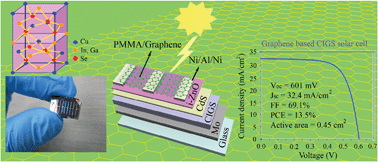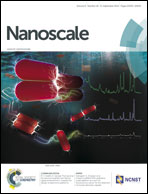Highly efficient graphene-based Cu(In, Ga)Se2 solar cells with large active area†
Abstract
Two-dimensional graphene has tremendous potential to be used as a transparent conducting electrode (TCE), owing to its high transparency and conductivity. To date graphene films have been applied to several kinds of solar cells except the Cu(In, Ga)Se2 (CIGS) solar cell. In this work, we present a novel TCE structure consisting of a doped graphene film and a thin layer of poly(methyl methacrylate) (PMMA) to replace the ZnO:Al (AZO) electrode for CIGS. By optimizing the contact between graphene and intrinsic ZnO (i-ZnO), a high power conversion efficiency (PCE) of 13.5% has been achieved, which is among the highest efficiencies of graphene-based solar cells ever reported and approaching those of AZO-based solar cells. Besides, the active area of our solar cells reaches 45 mm2, much larger than other highly efficient graphene-based solar cells (>10%) reported so far. Moreover, compared with AZO-based CIGS solar cells, the total reflectance of the graphene-based CIGS solar cells is decreased and the quantum efficiency of the graphene-based CIGS is enhanced in the near infrared region (NIR), which strongly support graphene as a competitive candidate material for the TCE in the CIGS solar cell. Furthermore, the graphene/PMMA film can protect the solar cell from moisture, making the graphene-based solar cells much more stable than the AZO-based solar cells.


 Please wait while we load your content...
Please wait while we load your content...